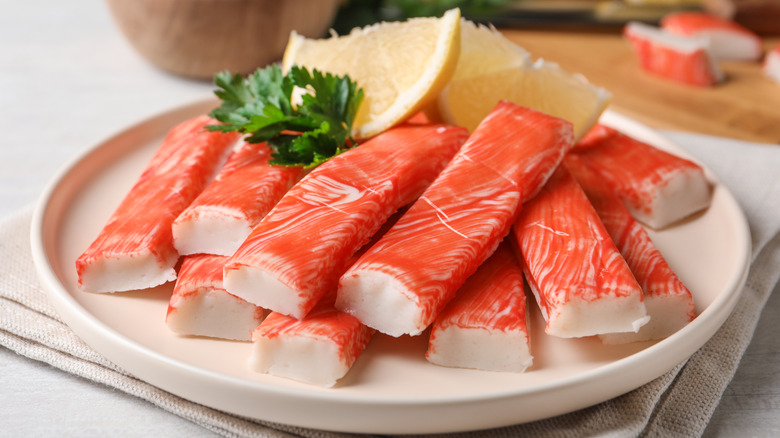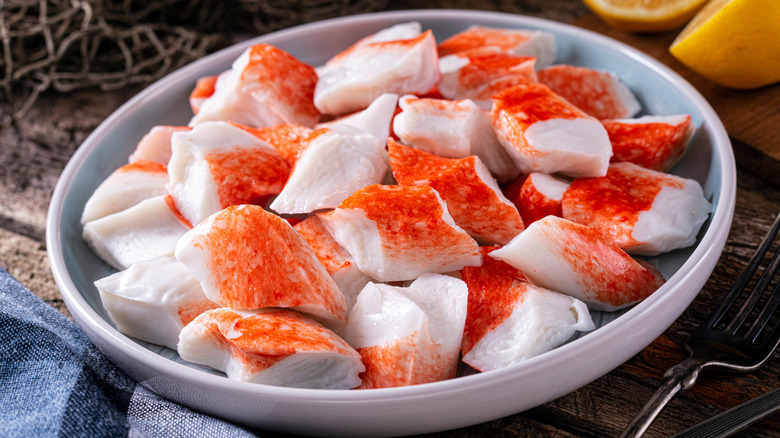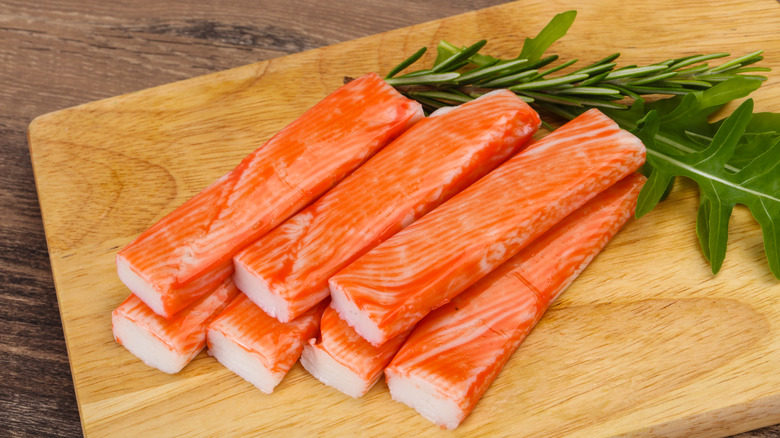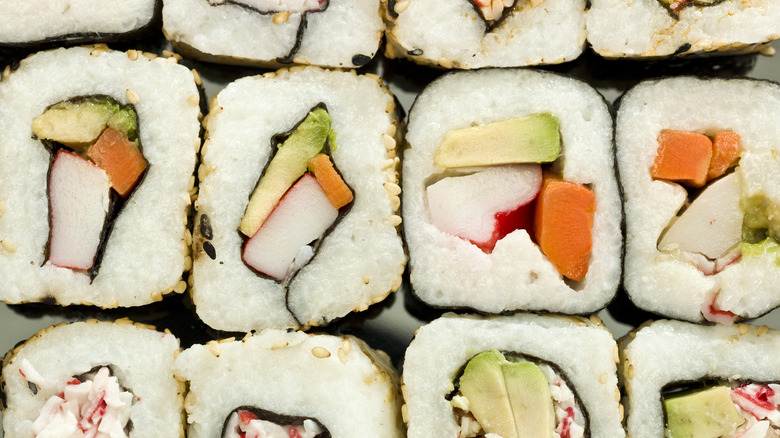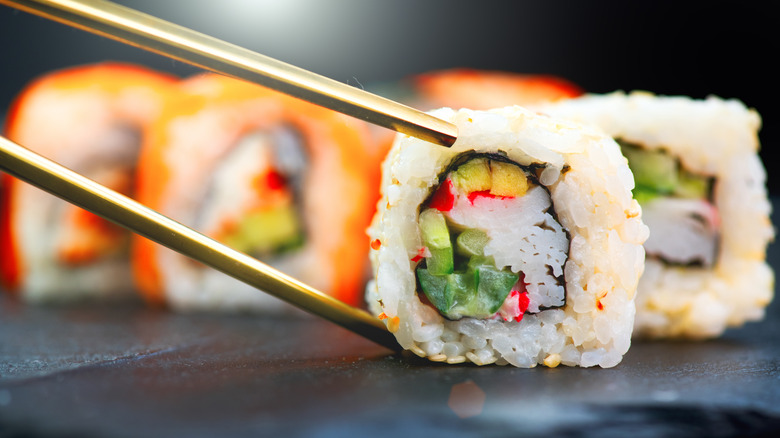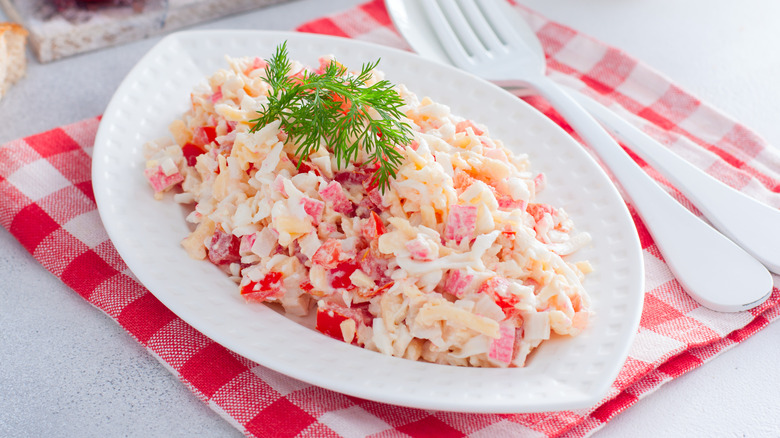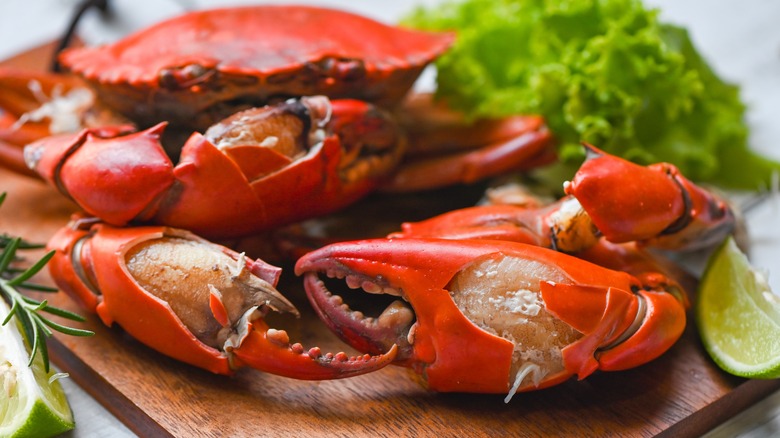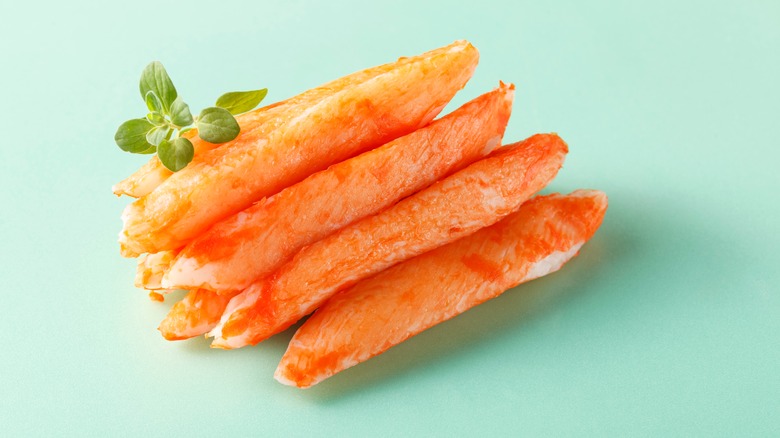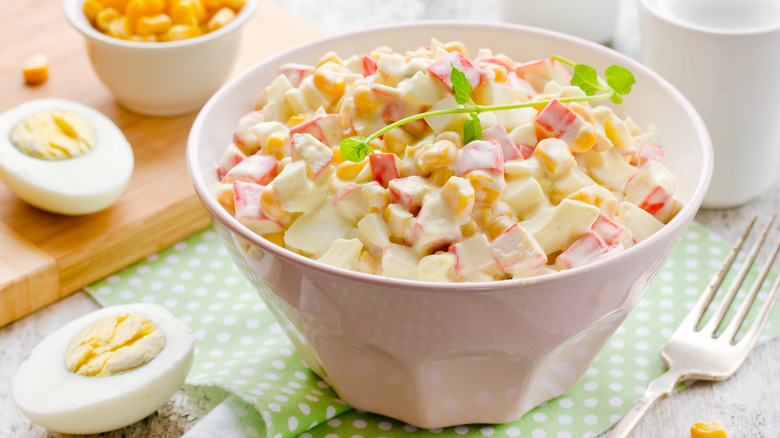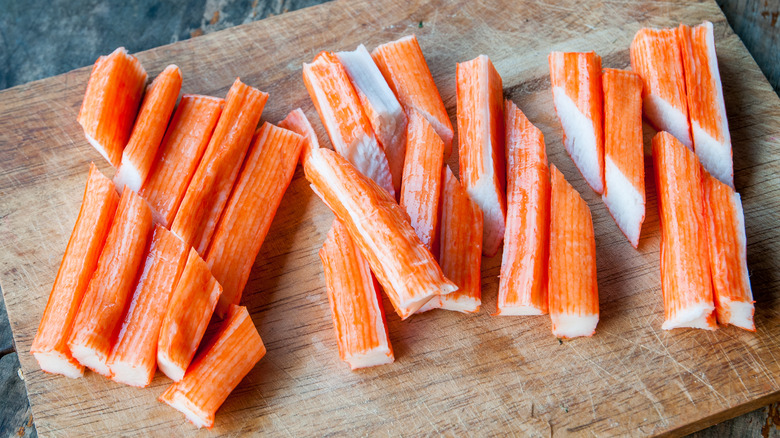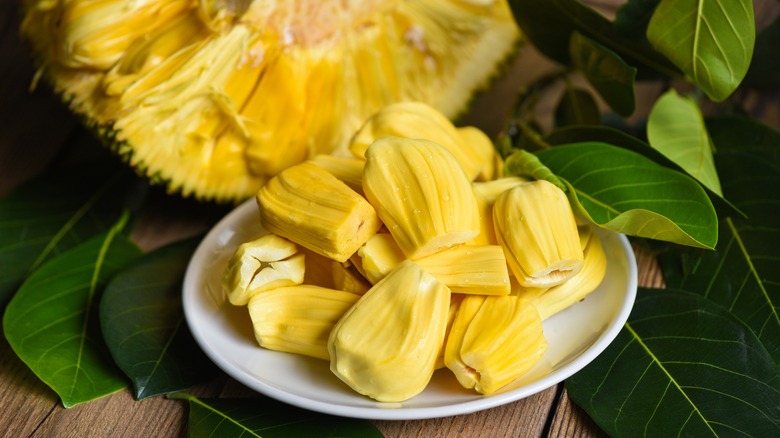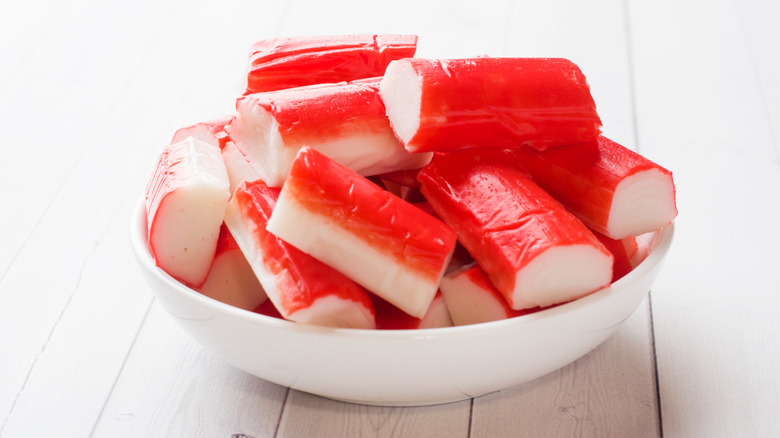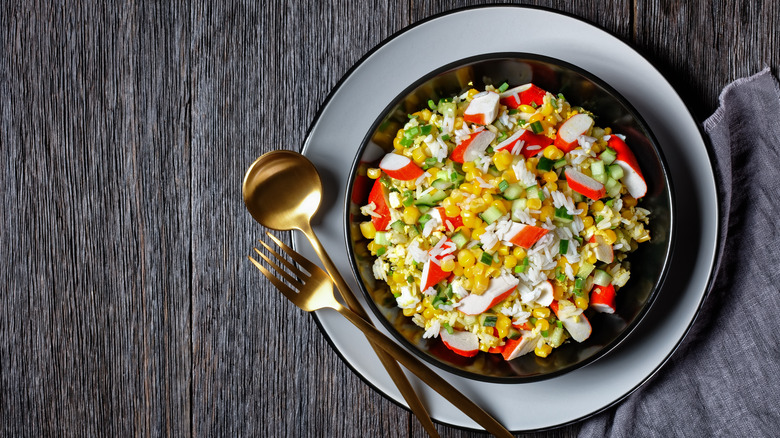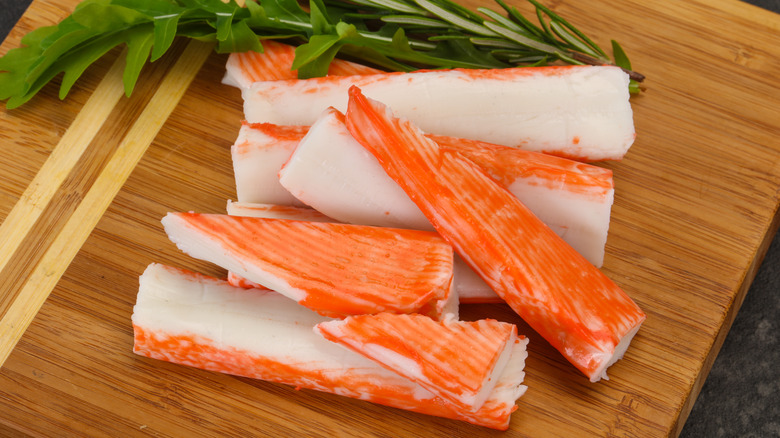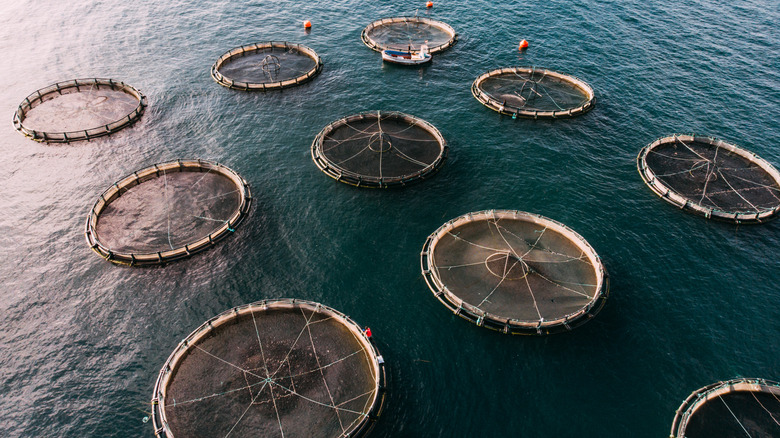What Is Imitation Crab?
You might be surprised to find out that your California roll doesn't actually contain crab. In most cases, it's actually something called imitation crab. Imitation meats are usually plant-based ingredients combined to mimic animal foods, but not in the case of imitation crab. This unmistakable orange and white, flaky Asian food staple is made of white fish but has a flavor and texture similar to real crab meat.
Why not use the real thing? Well, it's more expensive for one thing. And harder to come by. Now, you might be asking yourself if you should still eat this imposter in your sushi — or any dish for that matter — as a general rule is that "imitation" anything usually isn't the healthiest for you. However, that depends on the ingredients. Want to know more? Keep reading to find out whether there's something fishy about this crab impersonator or if this "crafted" catch is still good to eat.
Who invented imitation crab?
Although it's only been consumed in the U.S. for a few decades, imitation crab meat has a long history in Japanese cuisine, where it's commonly referred to as "surimi" or sometimes as kamaboko. Japanese chefs used to grind and salt fresh fish to preserve it. Hundreds of years later, a Japanese chemist realized he could stabilize and freeze surimi by adding sugar to the mix, thereby extending its shelf life. This, in turn, launched a massive global industry for the preserved fish product that is worth $1 billion today.
Food scientist Tyre Lanier was instrumental in establishing surimi in the United States — where it's often called the "hot dog of the sea" — in the 1980s. Lanier told Alaska Public Media that America became more receptive to the fish food because of its ability to stand in for king crab, which was hard to come by at that time due to the hardships of the king crab fishery in Kodiak, Alaska. It took a while to "catch" on, but it eventually took off.
Is imitation crab meat made of actual meat?
Unlike most imitation or fake meats, which are made of plant-based ingredients, imitation crab meat is still made from animal ingredients, and it is not suitable for vegetarians and vegans. Usually, surimi is made with a flaky white fish called Alaska pollock. From there, ingredients vary widely from product to product. High-quality surimi products will typically contain Alaska pollock with natural flavors from crab, lobster, scallops, or shrimp. However, other products aren't as pure and may contain ingredients like starch, sugar, sodium, and natural and artificial flavors. This mix creates a paste that is then molded into various shapes — the most common being the crab stick, which is coated with food dye to recreate the crab's natural coloring.
Sometimes, it may be difficult to distinguish real crab meat from imitation crab if it is not clearly marked on the package. The price will usually give it away, though, as the fake stuff is considerably cheaper. You can also look for the words "crab sticks" or "krab." Or, you can just do a quick scan of the ingredients list.
What is the point of imitation crab?
Why not just eat real crab, you ask? You absolutely can. However, crab meat, fresh and processed, can be very expensive. A pound of fresh crab meat can cost as much as $100. That's the premium stuff — jumbo lump — but even fresh backfin runs about $65 per pound. Compare that to a popular brand of imitation crab meat that costs around $5 per pound.
Now, we're only comparing price, not flavor. Obviously, imitation crab is a bit different when compared to fresh crab flavor. If you're inviting your fiancé's parents over for their first meal at your home and promising them fresh crab cakes, by all means, splurge on the real stuff. But if you're making a crab salad for a weeknight meal that you plan to eat in front of the TV, you could save yourself a lot of cash by using imitation crab meat.
What does imitation crab taste like?
The best way to describe imitation crab is that it tastes fine. If you enjoy crab, you'll like it — because they are similar enough. We've never had imitation crab that blew us away, but it's never been particularly gross, either. There are many myths about imitation crab, but one thing is for certain: the taste. Surimi has a mild flavor on its own, but by the time it's formed to mimic chunks of crab, the ultimate flavor is easily changeable with seasoning.
The main difference between imitation and real crab to our taste buds is the level of sweetness. While it has the brininess we love from real crab, imitation is just a touch sweeter — which is what sets it apart. If it's poorly made, it can be a little fishy — but not by much. To drive home how similar real and imitation crab taste (especially if you're not eating them alone but rather as part of a larger dish) just imagine if you swapped ultra-processed strawberry jam for raspberry jam on a bit of toast. Both are red, sweet, and tart. They taste just different enough — but are still mostly interchangeable.
Foods imitation crab is commonly found in
Imitation crab is commonly found in California rolls, an American sushi restaurant staple also containing cucumber and avocado and wrapped in vinegared rice and seaweed. It often also contains sesame seeds and small fish eggs. Crab rangoon is another Asian-inspired favorite consisting of imitation crab and cream cheese wrapped in wonton papers and deep fried. Fake crab meat may also be used in crab cakes on its own or in combination with real crab meat, as well as in a variety of seafood salads, from fresh and crisp to cream-based.
Other ways to use imitation crab meat in your dishes include tossing it with herbs to make a stuffing for salmon, adding it to a linguine or macaroni and cheese recipe, mixing it with cheese for a melty fondue, and combining it with peppers and cheese to make crab quesadillas. You can also use imitation crab in seafood salad sandwiches, baked bread bowls, to top a seafood pizza, and in a creamy corn chowder.
Is imitation crab meat healthy for you?
Imitation crab is a processed food, and like many processed foods, it's not as healthy as real, fresh crab meat. Processed foods have been altered during manufacturing to be made more convenient, extend their shelf life, or improve their flavor. They often have unhealthy ingredients such as sodium, sugar, fat, artificial flavors, and preservatives added to them. They may also be higher in calories and lower in nutrients than unprocessed foods.
Processed foods run the gamut from minimally processed to heavily processed. Even a particular food, such as imitation crab, may vary in its level of processing and nutritional value from product to product and brand to brand. However, the vast majority of imitation crab products contain added sodium and sugar, neither of which are healthy for you. Added sugar in your diet can lead to heart problems and type 2 diabetes. Additionally, too much sodium can increase your risk of stroke, high blood pressure, headaches, heart failure, kidney stones, kidney disease, osteoporosis, and stomach cancer.
Nutrition comparison of imitation and real crab meat
Ounce for ounce, real crab meat contains higher amounts of healthful nutrients like protein and iron and less of other nutrients like sodium that can be bad for you in excess. For example, a 3-ounce serving of fresh lump crab meat provides 17 grams of protein compared to only 6.5 grams found in imitation crab meat). Protein is a macronutrient you need in large amounts to preserve and build lean muscle mass and aid recovery after a workout or an injury.
Lump crab meat also contains more iron per serving with 1 milligram, compared to 0.3 milligrams in imitation crab. Iron is a crucial mineral for growth and development, and you need adequate iron in order to make healthy red blood cells. Fresh crab meat is also a richer source of the mineral calcium, which you need for strong bones. Three ounces of fresh lump crab provides 61.2 milligrams of calcium compared to only 11 milligrams in 3 ounces of imitation crab meat.
The only exception is if you are watching your cholesterol. In that case, you should be aware that fresh crab meat has 62.1 milligrams, compared to only 17 milligrams in imitation crab. However, if you don't have high cholesterol, eating crab or other shellfish once or twice a week likely won't cause a problem.
Imitation crab allergens
Over 170 foods can cause allergic reactions. The most common foods to which people are allergic in the United States are eggs, wheat, soy, sesame, milk, tree nuts, peanuts, fish, and shellfish. That means that both crab and imitation crab are going to be off-limits for a lot of people. If you have a fish allergy, then imitation crab is a hard "no" for you. If you have a shellfish allergy and are only allergic to crab and not fish, then some imitation crab brands might be a good substitute when you want the texture and flavor of crab meat; note, though that some brands include flavorings that are derived from shellfish, so it's important to check the label first.
You should also scan the ingredients label on the product as it might contain a variety of other ingredients that could cause an allergic reaction, including wheat starches, preservatives, and coloring.
Typically (but not always), imitation crab on its own doesn't contain any other major allergens, but if it is included as part of a recipe in a prepared food, then there could be an issue. Notably, imitation crab meat is commonly included in prepared Asian foods that may also contain soy, nuts, eggs, wheat, and other common allergens.
Imitation crab and dietary restrictions
Processed foods like imitation crab can be tricky to navigate when you have dietary restrictions because it's hard to know exactly what's in them. Imitation crab typically contains added sodium, so if you are on a restricted-sodium diet, you may need to skip it. Imitation crab meat can contain 450 milligrams of sodium per 3-ounce serving, which is around 20% of the Daily Value (DV). If you have congestive heart failure, for example, you should keep your daily sodium intake below 1,500 milligrams. Depending on the other foods you eat in a day, 450 milligrams might put you over your limit.
You might also need to take care if your doctor has told you to limit your sugar intake. A serving of imitation crab meat can contain over 5 grams of added sugars. If you have diabetes or pre-diabetes, it's important to watch your intake of added sugars, as even moderate amounts can affect your insulin levels.
Imitation crab meat may also contain gluten in the form of wheat starch. Individuals following a gluten-free diet should not eat it unless it is labeled gluten-free.
Is imitation crab safe to eat while pregnant?
According to the FDA, cooked crab is one of the best seafoods to eat while pregnant. This is because crab is relatively low in mercury compared to other food options from the ocean. You might be wondering if the same is true about imitation crab: While you should always confirm with your doctor to ensure a certain food is a good choice for you, imitation crab is also relatively safe to eat while pregnant. There are certain foods that the CDC classes as higher or lower risk for consumption by pregnant people, and imitation crab is in the latter bracket, as it's typically made from pollock, which is safe to consume in moderation while pregnant. Pollock, like actual crab meat, is low in mercury.
However, it's important to always be sure all your seafood is cooked, whether it's imitation crab or the real thing, before consuming it while pregnant. Uncooked or undercooked seafood can pose serious health risks to both you and your baby, like food poisoning and parasites. Imitation crab is cooked during production, but that may not be true of everything it's paired with, such as other ingredients in a sushi roll.
Is imitation crab kosher and halal?
If you keep kosher, you cannot eat shellfish. You can, however, eat fish with fins and scales. Alaska pollock, which is used to make imitation crab meat, does have fins and scales and, therefore, is considered kosher. However, real crab meat is not kosher, and some imitation crab meat may contain flavoring derived from real crab meat. Thus, imitation crab meat is only kosher if it is marked kosher. You can find certified kosher imitation crab meat at some major retailers in the United States when you need to get your California roll fix.
Likewise, imitation crab is not considered a halal food unless it is marked as such. Alaska pollock is considered halal, but as a processed seafood product, it's possible that it contains ingredients considered haram, including food coloring. Certified halal imitation crab products do exist, but they may be a little harder to come by than certified kosher versions.
Substitutes for imitation crab
Is there an imitation for imitation crab? Maybe. Nothing is going to be quite like the real thing, but you have a few options that can get close. And if they're not that close, at least they can still stand in place of imitation crab in your California roll so you're not just eating an avocado-cucumber roll.
First of all, you can find some plant-based versions of crab substitutes and crab cakes. The popular national brand Gardein makes fishless Mini Cr'b Cakes. They're not quite like imitation crab because they're breaded and fried, but they can still offer the imitation crab-like flavor you crave. Another possible sub is jackfruit. A tropical fruit, jackfruit flesh has a meaty texture that makes it a popular meat substitute. When combined with the right flavors, it can mimic pulled pork and crab meat and works very well in vegan crab cake recipes.
Heart of palm is a vegetable that forms the core of some kinds of palm trees. It's also sometimes called palm hearts, palmito, swamp cabbage, chonta, and palm cabbage. It's typically boiled and canned, and you can usually find it in the grocery aisle next to canned artichoke hearts. And if you can't find heart of palm, artichokes work as an imitation crab stand-in, too. Lastly, you can use tofu, which is particularly suitable for making vegan California rolls. Firm tofu has a meaty texture and mild flavor that can easily be adapted to all your vegan imitation crab-less recipes.
Cooking and storing imitation crab
Imitation crab is already cooked and ready to eat straight from the package. If you're adding it to sushi rolls, just slice it and roll it. If you're adding it to cooked dishes, you simply need to heat it through. There is no need to heat it to a high temperature as there is with raw seafood. Cooking it in the microwave is not recommended because it may change the texture.
If you bought too much imitation crab, gobble it up while it's fresh in your favorite dishes because freezing it isn't recommended, though it can be done. When it's fresh, you should store imitation crab meat in your refrigerator at between 32 and 38 degrees Fahrenheit.
Imitation crab products that have been pasteurized and vacuumed sealed can stay in the refrigerator for up to two months. Once it's been opened, you should consume the product within three days. Imitation crab that is packed loose in trays from your grocery store's fish case may last up to five days.
Like other seafood products, imitation crab has an expiration date, and you should open and consume it before the "use-by" date on the package. If it smells fishy, don't eat it! It's probably spoiled. Other signs of spoilage include a slimy surface and a sour flavor.
Ways to prepare imitation crab meat
If you're adding imitation crab meat to cold or room-temperature dishes, such as sushi rolls or cold seafood salads, then no prep work is necessary in terms of cooking. However, for some recipes, you might still feel like you want to cook the crab, and that's perfectly fine. If you want a healthy and easy preparation method, try steaming it. Steaming is a common way to prepare Asian foods, so it's especially suitable for the faux delicacy. As a moist heat cooking method, it will also help the imitation crab retain moisture and maintain a juicy texture better than dry-heat cooking methods like baking.
Sautéing is also a good method for cooking imitation crab because you can dial up the flavor. If you love fresh crab or lobster dipped in butter, you can get pretty close to that with the fake stuff by sautéing it with a pat of butter. Serve some drawn butter on the side, and you may be able to trick yourself into thinking the crab is the real deal.
Are there different varieties of imitation crab?
Imitation crab is quite similar to real crab meat in that it comes in many different varieties. One of the most popular are "flakes," which are not thin and flaky but rather thick and chunky. These come in more of a large, oblong shape and can be kind of chewy in texture. The meat also comes in a fish-cake variety also referred to as leg style, which, indeed, looks a bit more like the meat you might pull out of an actual crab leg. These imitation crab sticks also resemble cheese sticks in a way, as they pull apart into little strings if you prefer to enjoy them that way.
Finally, there's chunk style. This doesn't look like variable torn strips of meat like the flakes; rather, it's more of a solid ball shape. Although the ingredients for the different varieties of imitation crab are roughly the same, these differences make certain types more appealing for certain dishes. When using imitation crab, flakes might go best in a seafood salad, fish cake or leg style in sushi rolls, and the chunky bits might shine in a seafood cocktail. The shapes are meant to help the person preparing the meal, as they don't have to cut up the meat any more — it's already ready.
What are the best imitation crab brands?
Whether you are thinking about trying the food for the first time, or eat it often and would like to make sure you're getting the most bang for your buck, we have strong feelings about our recommendations. We tried and ranked six imitation crab brands and felt that the winner was clearly Kroger Crab Select. We tried it in leg style, but if you prefer your imitation crab another way, it also comes in flake and chunk form, too. We liked it the best because it tasted the most like real crab out of all the brands sampled. It didn't have that strange gummy texture that imitation crab can sometimes have, making it nice and firm.
A close second on our list are the Seafood Snackers from TransOcean, which also come in a few different styles. While the Seafood Snackers were a little bit too firm, they still tasted great and weren't too fishy. We have to warn you about a brand to avoid, though. Hy-Vee Fish Market Imitation Crab Meat came in last for a reason. It was very fishy tasting and also had a weird kick to its aftertaste.
Is imitation crab sustainable?
As imitation crab is created from fish, the overall sustainability of the meat is debatable. As with any food, the final product is only as sustainable as the company that produces it is willing to make it. Some companies do this by running their processing plants with hydropower, as well as spreading out their fishing locations, so as not to overfish one particular area. Those practices aside, the distance the Alaska pollock has to travel from ocean to plate can increase imitation crab's carbon footprint.
To confirm the imitation crab you are buying is sustainable, it's best to research your favorite brand. Companies that make an effort to enforce greener fishing practices will have information available on their websites about how they make this a reality. From there, you can decide if the brand's overall carbon emissions, supply chain size, and policies against overfishing match what you think is ethical and good for the Earth.
